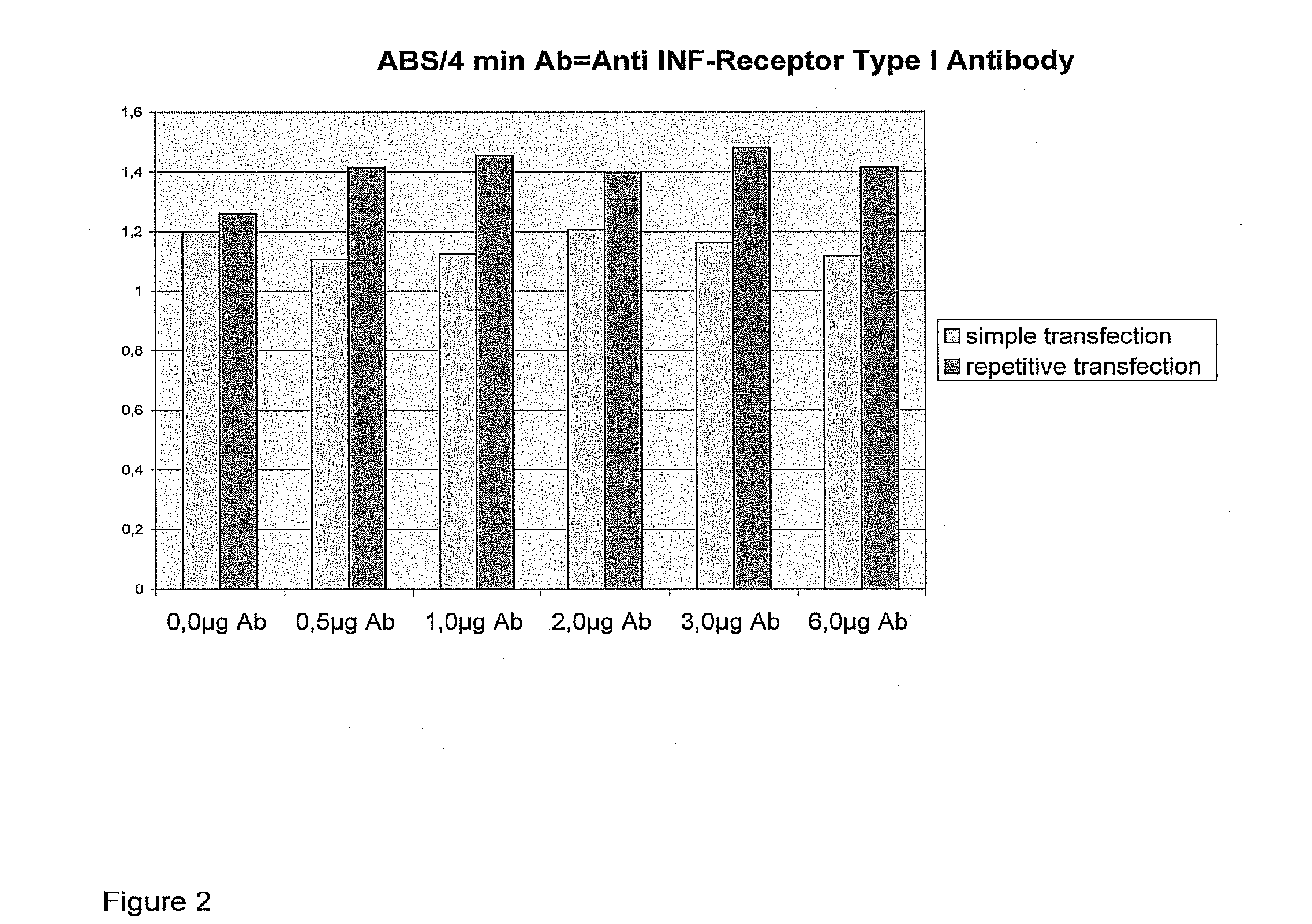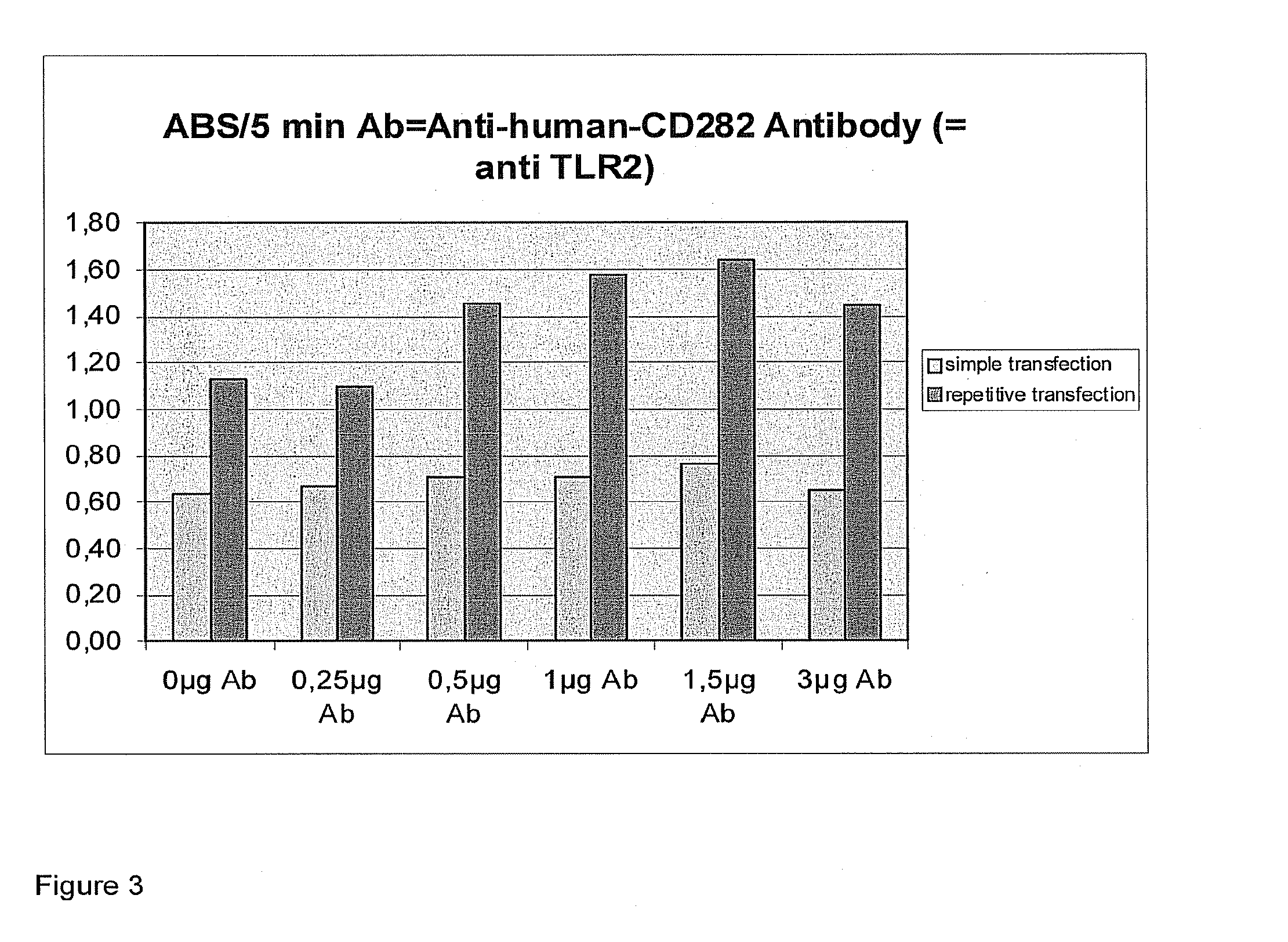Transfection results of non-viral gene delivery systems by influencing of the innate immune system
a technology of innate immune system and gene delivery system, which is applied in the field of transfection results of non-viral gene delivery system by influencing the innate immune system, can solve the problems of low ph value, substantially more difficult to clarify the function of various genes, and misdirect immunity
- Summary
- Abstract
- Description
- Claims
- Application Information
AI Technical Summary
Problems solved by technology
Method used
Image
Examples
example 2
[0301]Material: 1. Mouse monoclonal Antibody against Human Interferon Alpha / Beta Receptor Chain 2 (CD118), clone MMHAR-2, isotype Ig2a, C=0.5 mg / ml in PBS (phosphate buffered saline) containing 0.1% bovine serum albumin (BSA), PBL Biomedical Laboratories, Product No. 21385.
[0302]Detailed Description of Experiment:
example 1
Analogous to Example 1
[0303]Differences:
[0304]First of all 400 μl of PBS (phosphate buffered saline) are added to the antibody (Mouse monoclonal Antibody against Human Interferon Alpha / Beta Receptor Chain) and gentle mixing is carried out. The antibody now has a concentration of 0.1 μg / μl. The wells of the 24-well plate are supplied with the following amounts of antibody:
123456A0 μg (0 μl)0.5 μg (5 μl)1 μg (10 μl)2 μg (20 μl)3 μg (30 μl)6 μg (60 μl)B0 μg (0 μl)0.5 μg (5 μl)1 μg (10 μl)2 μg (20 μl)3 μg (30 μl)6 μg (60 μl)C0 μg (0 μl)0.5 μg (5 μl)1 μg (10 μl)2 μg (20 μl)3 μg (30 μl)6 μg (60 μl)D0 μg (0 μl)0.5 μg (5 μl)1 μg (10 μl)2 μg (20 μl)3 μg (30 μl)6 μg (60 μl)
[0305]The addition of lipoplex takes place after 5 hours' incubation time with the antibody.
[0306]Result:
[0307]Incubation time: 4 min
[0308]Average Value of 3 Measurements:
123456A1.2691.1131.1631.1851.2141.084B1.1321.1021.0881.2291.1131.154C1.1271.4381.5331.3781.5041.367D1.3951.3931.3771.4171.4591.467
[0309]Lines A and B are ...
example 3
[0311]Further experiments with antibodies to receptors and cytokines.
[0312]Detailed Description of Experiment:
[0313]1st day HeLa cells are sown in a 48-well plate, the cells being plated out at a cell count of 1.2*105 cells per well of 250 μl of complete medium (10% FCS). Incubation is then carried out in a CO2 incubator (10%) for 24 hours.
[0314]2nd Day:
[0315]The antibody is adjusted to a concentration of 0.05 μg / μl with PBS. The wells of the 48-well plate are then supplied with the following amounts of antibody:
1234A0 μg(0 μl)0 μg(0 μl)0 μg(0 μl)0 μg(0 μl)B0.25 μg(5 μl)0.25 μg(5 μl)0.25 μg(5 μl)0.25 μg(5 μl)C0.5 μg(10 μl)0.5 μg(10 μl)0.5 μg(10 μl)0.5 μg(10 μl)D1 μg(20 μl)1 μg(20 μl)1 μg(20 μl)1 μg(20 μl)E1.5 μg(30 μl)1.5 μg(30 μl)1.5 μg(30 μl)1.5 μg(30 μl)F3 μg(60 μl)3 μg(60 μl)3 μg(60 μl)3 μg(60 μl)
[0316]Incubation is then carried out in an incubator for 5 hours or 0.5 hour, depending upon the antibody. The lipoplexes are then prepared. For that purpose, 13 μl of DNA (pCMV-lacZ) a...
PUM
| Property | Measurement | Unit |
|---|---|---|
| Time | aaaaa | aaaaa |
| Time | aaaaa | aaaaa |
| Volume | aaaaa | aaaaa |
Abstract
Description
Claims
Application Information
 Login to View More
Login to View More - R&D
- Intellectual Property
- Life Sciences
- Materials
- Tech Scout
- Unparalleled Data Quality
- Higher Quality Content
- 60% Fewer Hallucinations
Browse by: Latest US Patents, China's latest patents, Technical Efficacy Thesaurus, Application Domain, Technology Topic, Popular Technical Reports.
© 2025 PatSnap. All rights reserved.Legal|Privacy policy|Modern Slavery Act Transparency Statement|Sitemap|About US| Contact US: help@patsnap.com



